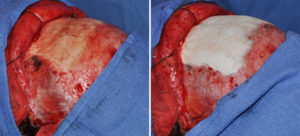Background: The forehead occupies a large surface area of the face and the broadest uninterrupted facial contour. Between the brows bone and the frontal hairline, it is a vast expanse of skin that can only be judged by its size and overall shape. While its more superficial features undergo frequent aesthetic manipulations (Botox, injectable fillers and brow lifts), the bony shape of the forehead does not. This, however, does not mean it is not capable of being changed but it is more of a surgical endeavor to do so.
The shape of the forehead can be very gender specific as is well known in facial feminization surgery as well as facial masculinization surgery. Beyond the very gender specific feature of the more prominent male brow bones, the female forehead has a more vertical inclination as seen in the side view and a more rounded shape between the temporal lines on the sides of the forehead best seen in the oblique or superior-inferior views.
Female forehead reshaping to create a more pleasing shape often involves augmentation of the frontal bone in a shape specific manner. There are two surgical techniques to perform it using different materials and incisional approaches. The traditional technique involves the application of bone cements placed through a wide open exposure. Such exposure is needed because bone cements, regardless of their material composition, are applied in a putty-like fashion and then shaped and allowed to set. Such applications can not be disturbed by the pressure of a tight overlying scalp/forehead flap less significant contour deformities be created in the augmentation. Not to mention that getting the right forehead shape initially requires good visualization.
Case Study: This young female had a more recessed and triangular forehead shape with a slight backward vertical inclination.


Hydroxyapatite is one option for a forehead augmentation material. One could argue it is the ideal forehead augmentation as its inorganic hydroxyapatite crystals allows direct bone bonding to it. But because of how it is applied and shaped it requires a full coronal incision to use it properly. In addition at a material cost of $100/gram, and a typical case may require at least 50 to 75 grams, adds considerably to the overall expense of the surgery.
Highlights:
1) The shape of the female forehead is one of greater convexity and a more round shape when viewed from above or below.
2) One method of forehead augmentation is the use of bone cements done through a full coronal scalp incision.
3) Augmenting the lateral or temporal sides of the forehead, with or without increased central projection, creates a more vertically inclined shape that is rounder.
Dr. Barry Eppley
Indianapolis, Indiana


